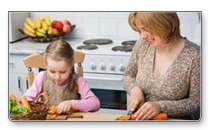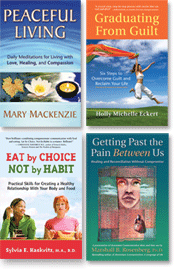Cooking Up Peace," continued
In the movie, “Julie & Julia,” Child is in ecstasy eating food, preparing it, sharing it. Her husband oohs and ahhhs over each taste she offers him. The same is true for Julie Powell. Powell is the writer who embarks on a quest to create one of Child’s recipes a day for one whole year. Her husband and friends seem to melt the moment her duck or chocolate soufflé rolls onto their tongues.
Appreciation, connection, joy. Isn’t that a common wish, especially for the holidays? Sumptuous food, a smiling, satisfied family. The sense that we’re each contributing something and are appreciated for our creations: whether it’s pumpkin pie or graciousness.
But our most common holiday settings: the kitchen, the dining room table, can easily become minefields. You are happily talking and stirring your special Thanksgiving stew, when Aunt Esther unexpectedly salts it. “Everything tastes better with more salt.”
You smile, but you’d actually like Aunt Esther to turn into salt. You offer to help your sister, the hostess, clean up. She thanks you and then criticizes your every move.
According to Sylvia Haskvitz, author of Eat by Choice, Not by Habit, becoming aware of family patterns around cooking and eating may shift your culinary experiences from frustration, irritation, or anger to real celebration.
Instead of eating your words, Haskvitz suggests saying something to Aunt Esther like: “I feel discouraged when I see you salting the stew without checking in with me first. Some of those eating with us are not using salt and I was hoping everyone at the dinner would be able to enjoy the stew. How are you taking that in?”
As for Sister, how about: “When you say I left soap on the glass and I’m using the wrong towel to dry the dishes and there is still some dirt on the counter, I feel frustrated. I really want to support you so you’re not up until midnight and I want some reassurance that my help is appreciated. Can you tell me how this all lands with you?”
Now leave the Aunt and Sister alone and take a moment to recall some of your own childhood experiences.
Was your brother considered the cooking maven, you the klutz?
Did your mother work and expect you to cook for your siblings? Or did she shoo you out of the kitchen?
One woman’s dad rushed into the kitchen every time she picked up a knife for fear she’d chop off a pinky. He hovered over her, seeing disaster at every stir of the pot. Today she’s anxious when anyone else tries to help her cook.
Healing from such experiences often takes self-empathy. Take the woman with the hovering father.
“I’m guessing the woman would have liked to have been trusted to take care of herself, says Haskvitz. “Likely Dad was wanting safety and well-being for those he cares about.”
In her quest to strengthen our healthiest relationships with our body and food, Haskvitz teaches classes in cooking and compassionate communication.
Ten or so people gather to prepare a meal together and talk about “people’s emotional needs around food. We acknowledge their fears, what keeps them from wanting to be in the kitchen. There is a lot of pain from past messages about food and eating. Cooking, eating together, sharing our food and eating history and receiving empathy helps us heal and makes being in the kitchen fun again.”
Class member Chris Amoroso grew up in a home above the neighborhood grocery store his family ran. “Our meals were with one ear on the store bell while we were eating so it was nothing to wolf down our meals in minutes. Even when I was older. I learned to eat really fast.”
Once while home late, he sat down to eat with one of his five kids. “I was wolfing down my food, talking, when my daughter said, ‘Dad, time’s up.’ That caught my attention. I’d been eating for two minutes and I was almost done.”
For him, cooking a meal with others was revolutionary.
“For me to have the meal be more than feeding the body, more of a soul experience and coming together in a group --it was like a symphony. We had this combined wisdom in the room. Everybody was learning as we were moving along,” he said.
To create your own holiday symphony, “Stop the beat-up from your past memories and connect with your longings, your hopes and needs right now,” says Haskvitz. “Pause when you get triggered. Go inside to get clear on which need is stirred up in the moment. Once you have that awareness, you have an abundance of choices on what to do next. This is true freedom and joy!”
Explore this topic more with Eat by Choice, Not by Habit by Sylvia Haskvitz, or contact Sylvia at 520-572-9295 to learn more about one-on-one coaching to transform your relationship with your body and food.
Jan Henrikson is the editor of Eat by Choice, Not by Habit written by Sylvia Haskvitz. In between writing, editing, and coaching other writers, Jan eats as joyfully and mindfully as possible
Keep learning these vital communication skills with these books and training resources:




